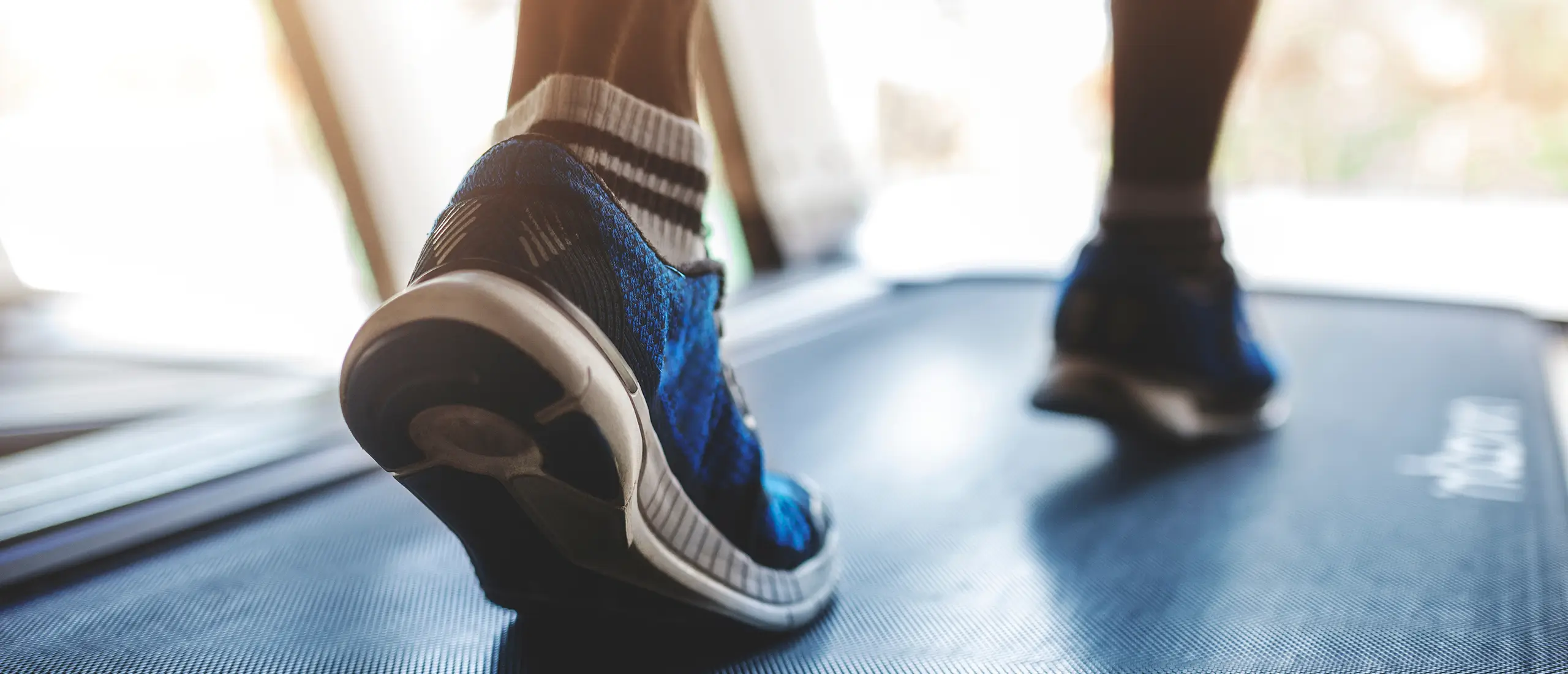
The Surprising Reason TikTokers Are Walking Backwards on the Treadmill
Tired of your regular walking workouts? TikTok is buzzing with a trend to spice things up: walking backward on the treadmill.
One TikToker posted how backward treadmill walking has helped strengthen his knee, and another shared that reverse treadmill walking improved his balance and stability, increased quad definition, and enhanced knee and ankle health.
Unlike many TikTok fitness trends, backward walking has legit benefits, according to Dr. Jereme Schumacher, PT, DPT, FRCms, CF-L1, a Sports Performance Physical Therapist at Bespoke Treatments. Why you should try it and how, below.
Benefits of Walking Backwards on a Treadmill
From general fitness to knee rehabilitation, here are a few reasons to walk backward the next time you hop on the treadmill.
Improves Gait and Mobility
Backward walking can improve mobility in your knees, hips, and ankles; plus, it can prevent pain and shock absorption in comparison to regular walking. Exactly why physical therapists use reverse walking to improve gait after certain injuries, surgeries, or illnesses (1).
“Particularly in ankle injuries, it can be painful to toe-off during regular walking,” says Schumacher. “Backwards walking can improve ankle dorsiflexion—directly improving your ability to walk forward.”
@stretch_pad Walking backwards can help you walk forward better. Just tricky to walk backwards at first. #fypシ #physicaltherapy #stretchpad ♬ green glob MLM - superior ABBA enjoyer
Improves Quad Function
“Backward walking can be effective in promoting increased quadriceps activation—which is essential when trying to improve greater knee extension (4),” says Schumacher. Your quads are important for straightening your knee, and tightness or weakness in your quads can lead to knee pain.
Exercises that isolate the quads involve straightening your knee, like leg extensions, or walking backward. “This movement is crucial for individuals after knee surgeries such as a total knee replacement or an ACL surgery,” Schumacher adds.
As you walk backward, your quad is active as your knee straightens and you move from toe to heel. Walking at a slow pace of 0.5 to 1.0 miles per hour will help you get the hang of walking backward, which he notes can feel awkward at first. By walking slowly, you’ll have the time to focus on activating your quads through each step.
@jd_fitnesss Reply to @manospsd Try these if you wanna strengthen your knees🙌🏽 #knees #kneepain #legday #fitnesstips #fypシ #viral ♬ The Assignment - Tay Money
Boosts Heart Rate and Calorie Burn
“Walking backward can multiply your workout efforts,” says Schumacher. “When compared to regular walking, it boosts your heart rate in response to the increased challenge (2).”
Walking backward also burns more calories than walking forward. A brisk walk at 3.5 miles per hour can rack up 4.3 METs (metabolic equivalents) while walking backward at the same speed earns 6.0 METs, according to the ACSM Compendium of Physical Activities. Overall, backward walking boosts calorie burn by 60 percent per minute of exercise.
Builds Coordination and Stability
“Backward walking can be beneficial to improve coordination and balance due to the challenge of moving in an unfamiliar direction,” says Schumacher. He points out that this challenge increases core activation. It can also help to strengthen the muscles around your ankle joint like small muscles in the foot, calves, and shins.
This functional strength can help increase your balance and stability and is especially helpful for everyday scenarios like walking on uneven sidewalks, or during running workouts when you’re picking up the pace. “When performed safely, walking backward can also be beneficial for older adults to decrease the risk of falling,” Schumacher adds.
How To Walk Backwards on a Treadmill
Before giving backward walking a try, if you have an injury or pain, it’s important to check with a PT to ensure walking backwards on a treadmill is safe for you.
Once you’re cleared, start slow to get into a good rhythm. Backward walking will put your coordination and balance to the test, so you might find that simply walking backward at a slow speed is enough of a challenge to start.
You can increase your speed in small increments as you get the hang of it. Depending on your comfort level, it might take multiple sessions to work your way up, or more athletic individuals might feel ready to crank it up right away. Listen to your body, and play safe.
To safely walk backwards on the treadmill:
- Stand on a treadmill facing towards the rear of the machine, placing your feet on either side of the belt.
- Attach the safety clip. This will automatically stop the belt if you get too far away from the front on the treadmill to minimize your risk of falling.
- Start the treadmill, and check the treadmill is moving at its slowest speed.
- Grab onto the handrails of the treadmill.
- Hop onto the treadmill, and start walking by reaching one leg backward and landing on your toes. Roll onto your heel as your knee naturally straightens as it comes under you.
- Repeat. As you get more comfortable you can increase the speed, or ideally have a friend, trainer, or PT increase the speed slowly for you.
SHOP TREADMILLS
How Long to Walk Backwards on a Treadmill
The length of your workout will ultimately depend on your goal. If injury or surgery rehab is your focus, we recommend starting with slow one-minute intervals focused on building strength, coordination, and mobility. Start in small increments and build up to little increases in speed, or time as you can handle it.
If you’re walking backward for general knee and ankle longevity, doing a few short intervals one to two days a week is enough to maintain your strength and mobility. Try adding it at the end of your workout, and stay slow to focus on muscle activation (rather than speed where form can start to break down).
For people looking to push intensity, intervals at higher speeds, or reverse walking for longer periods of time ranging from five to 20 minutes will help jack up your heart rate and burn more calories.
Handrails When Walking Backwards?
Definitely use the handrails to start. Walking backward with your hands off the side rails should only be done once you’ve built the confidence in your balance to do so. Moving backward requires core and ankle stability, and strong legs, so if you notice any weakness, keep your hands on or close to the handrails for stability.
Walking backward without gripping the handrails will help build more strength and balance because without them your body will have to work to hold itself up. When you’re ready to wean yourself off of the handrails, first try holding just one, and then try not using them at all.
Treadmill On or Off?
Walking backward with the treadmill turned off is called reverse deadmill walking. Deadmill walking has gained popularity because it requires your muscles to work harder to power the belt forward. When the treadmill is turned on you aren’t up against resistance, and the treadmill will keep moving whether you do or not. But with the power off you have to do all the work.
If you’ve mastered backward walking and are ready for your next challenge, reverse deadmill walking is a great progression. Just keep in mind that some treadmills aren’t designed for use when turned off, and it could damage the motor.
The best treadmills to use for deadmill walks are manual treadmills which are designed specifically for this kind of workout. And, some even include adjustable resistance, so you can continue to push heavier loads as you get stronger.
SHOP MANUAL TREADMILLS
References
1. Balasukumaran, T. et al (2018). The Effectiveness of Backward Walking as a Treatment for People With Gait Impairments: A Systematic Review and Meta-Analysis.
https://journals.sagepub.com/doi/10.1177/0269215518801430
2. Masumoto, K. et al (2019). Metabolic Costs During Backward Running with Body Weight Support https://www.thieme-connect.de/products/ejournals/abstract/10.1055/a-0806-7537
3. Alghadir, A. et al (2019). Effect of 6-Week Retro or Forward Walking Program on Pain, Functional Disability, Quadriceps Muscle Strength, and Performance in Individuals With Knee Osteoarthritis: A Randomized Controlled Trial https://bmcmusculoskeletdisord.biomedcentral.com/articles/10.1186/s12891-019-2537-9









